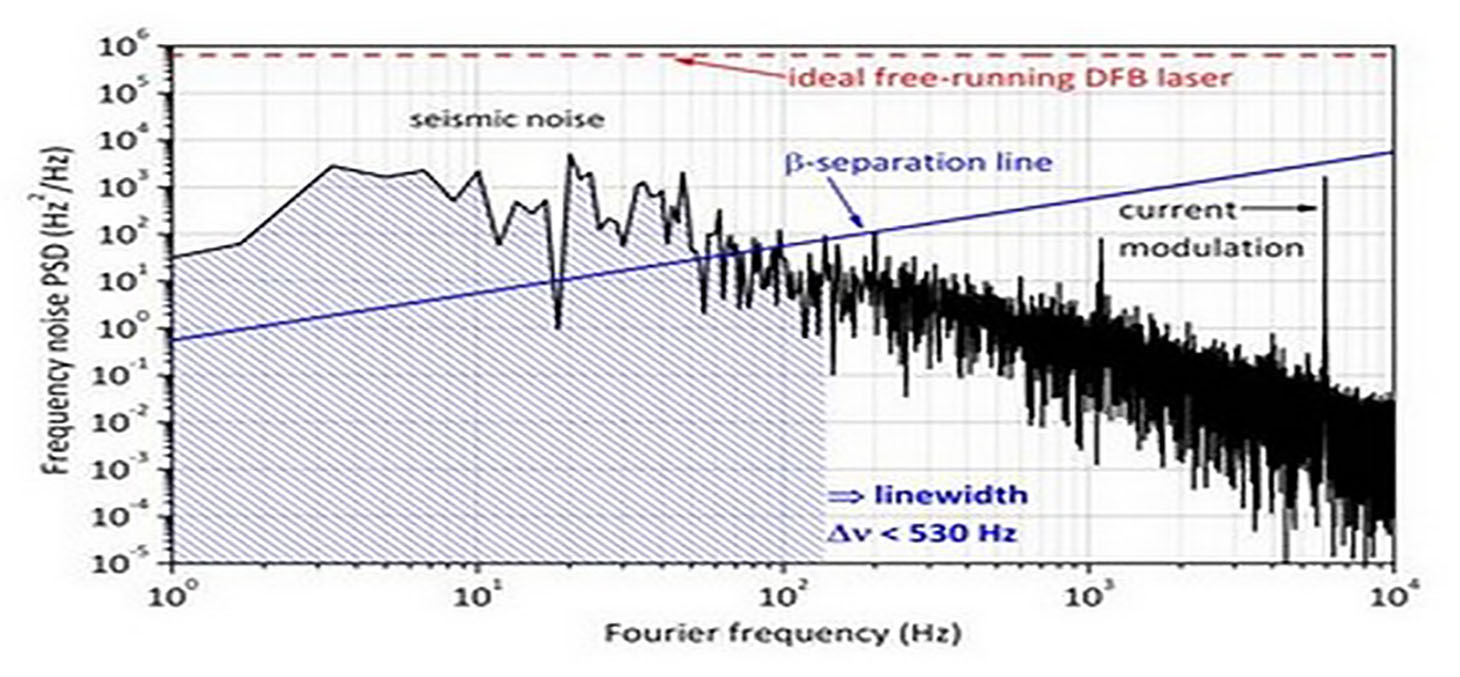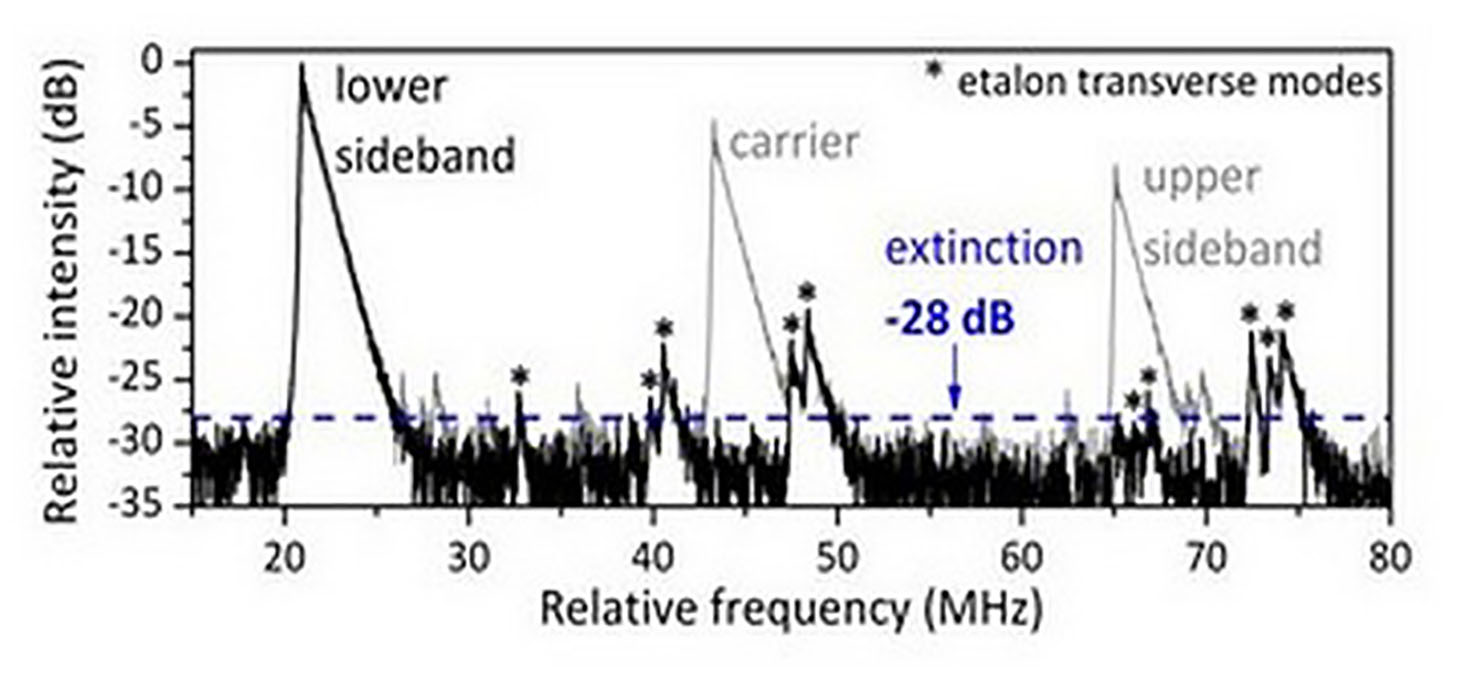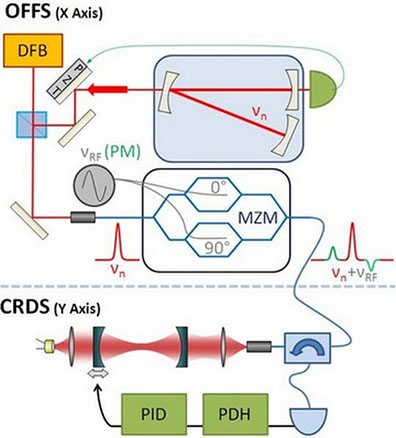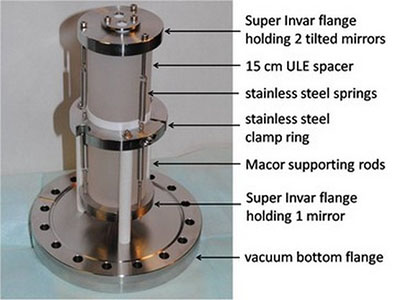- Share
- Share on Facebook
- Share on X
- Share on LinkedIn
Line profile metrology is one of the main topics in current high resolution spectroscopy. The recording of absorption profiles with high accuracy on both the frequency (X) and absorption (Y) axes is crucial for a large number of applications including satellite remote sensing [1], optical measurement of isotope ratios [2] or the "re-determination" of the Boltzmann constant [3]. These studies support and induce considerable progress in the theoretical understanding of line shapes (cf. [4]) which now take into account phase shift and velocity change processes induced by collisions.
Through the present activity, our group contributes to the production of very high quality reference line profiles in order to test theoretical models at unmatched signal-to-noise and linearity levels and to meet the needs of the fascinating applications we have mentioned. To this end, we have designed and developed a novel type of spectrometer that combines a highly monochromatic, highly stable and tunable laser with an ultra-sensitive decay-time absorption measurement system [5], a technique we call Optical Feedback Frequency Stabilized Cavity Ring-Down Spectroscopy (OFFS-CRDS) and which is described below.
Experimental setup of the OFFS-CRDS: The CRDS optical cavity is locked to the emission frequency of a laser system integrating a DFB laser diode itself optically locked to a mode of a reference ultrastable optical cavity. In addition, the frequency of the laser system is radio frequency tunable using an integrated Mach-Zehnder modulator as an optical single sideband generator.
The heart of the set-up is a laser source with an emission width of less than kHz and whose operating principle is based on the optical feedback induced on the laser chip by the resonant photons re-emitted by an ultra-stable V-shaped optical cavity developed in our laboratory [6].
Ultrastable V-cavity developed at LIPhy: it is made of very low expansion materials intimately put in contact. The constituent parts have been machined with great precision to ensure automatic mechanical alignment of the mirrors during assembly.
The photons of the cavity compete with the spontaneous emission of the laser, which leads to a refinement by several orders of magnitude of its emission width and to its purely optical slaving to a mode of the cavity whose frequency drifts less than 20 Hz/s.

Frequency noise and linewidth of an optically locked laser: The noise spectral density of the locked laser, measured here using a very high fineness optical standard, indicates that the laser's emission width is less than 530 Hz (instead of 2 MHz in unlocked operation)
This laser source is continuously tunable to 1 THz around 1590 nm by locking on one of the modes of the V-cavity and by using an original optical generation system of a single sideband [6] shifted up to 40 GHz with an excellent spectral purity and an accuracy to the millihertz. Its physical principle is based on an integrated component consisting of Mach-Zehnder interferometers controlled in voltage by electro-optical modulation (MZM) [7].

Spectral purity of the sidebands: transmission of a scanning Fabry-Perot cavity reveals that the carrier and the other sideband can be attenuated by more than 28 dB from the wanted signal.
The CRDS resonator is finally hooked onto the intense sideband of the laser source. This optimizes the injection of photons into the resonator and transfers the stability of the ultrastable cavity to the measurement system. Moreover, the versatility of the MZM allows to get rid of the use of an acousto-optic to interrupt the laser (cf. principle of the CRDS) and even of the electro-optic modulator generally used in the Pound-Drever-Hall type of control schemes. Thanks to its fine and stable laser source it is possible to reach high repetition rates of ring down events, to approach the fundamental limit of the measurement (photon shot noise) and to reach a detection limit of the order of 10-13 cm-1 : unprecedented performances [8],[9],[10].
References
[1] M. Schneider, F. Hase, J.-F. Blavier, G.C. Toon, T. Leblanc, "An empirical study on the importance of a speed-dependent Voigt line shape model for tropospheric water vapor profile remote sensing", Journal of Quantitative Spectroscopy and Radiative Transfer, Elsevier, 2011, 112 (3), pp.465-474. ⟨10.1016/j.jqsrt.2010.09.008⟩
[2] Antonio Castrillo, Hemanth Dinesan, Giovanni Casa, Gianluca Galzerano, Paolo Laporta, Livio Gianfrani, "Amount-ratio determinations of water isotopologues by dual-laser absorption spectrometry", Physical Review Online Archive (PROLA), American Physical Society, 2012, 86 (5), pp.052515. ⟨10.1103/PhysRevA.86.052515⟩
[3] A., Cygan, D., Lisak, R. S., Trawiński, R., Ciuryło, "Influence of the line-shape model on the spectroscopic determination of the Boltzmann constant", Physical Review Online Archive (PROLA), American Physical Society, 2010, 82, pp.032515 ⟨hal-01103912⟩
[4] N.H. Ngo, D. Lisak, H. Tran, J.-M. Hartmann, "An isolated line-shape model to go beyond the Voigt profile in spectroscopic databases and radiative transfer codes", Journal of Quantitative Spectroscopy and Radiative Transfer, Elsevier, 2013, 129, pp.89-100. ⟨10.1016/j.jqsrt.2013.05.034⟩
[5] Samir Kassi, Alain Campargue, "Cavity ring down spectroscopy with 5 × 10-13 cm-1 sensitivity" Journal of Chemical Physics, American Institute of Physics, 2012, 137, pp.4201. ⟨10.1063/1.4769974⟩
[6] Johannes Burkart, Daniele Romanini, Samir Kassi, ''Optical feedback stabilized laser tuned by single-sideband modulation", Optics Letters, Optical Society of America - OSA Publishing, 2013, 38, pp.2062. ⟨10.1364/OL.38.002062⟩
[7] M. Izutsu, S. Shikama, T. Sueta, "Integrated optical SSB modulator/frequency shifter", IEEE Journal of Quantum Electronics, Institute of Electrical and Electronics Engineers, 1981, 17 (11), pp.234201. ⟨10.1109/JQE.1981.1070678⟩
[8] Johannes Burkart, Daniele Romanini, Samir Kassi, "Optical feedback frequency stabilized cavity ring-down spectroscopy", Optics Letters, Optical Society of America - OSA Publishing, 2014, 39 (16), pp.4695-4698. ⟨10.1364/OL.39.004695⟩
[9] Johannes Burkart, Daniele Romanini, Samir Kassi, "Optical feedback stabilized laser tuned by single-sideband modulation", Optics Letters, Optical Society of America - OSA Publishing, 2013, 38, pp.2062. ⟨10.1364/OL.38.002062⟩
Actors
Samir KASSI
Daniele ROMANINI
OFFS-CRDS

Experimental set-up

- Share
- Share on Facebook
- Share on X
- Share on LinkedIn